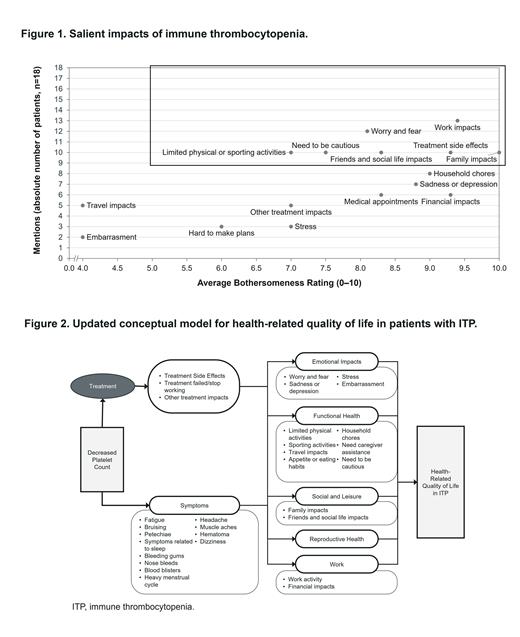Background
Immune thrombocytopenia (ITP) is an autoimmune disorder characterized by increased risk of bleeding, as well as thromboembolic event. ITP as well as the currently available treatments for the disease can have a debilitating impact on patient's health-related quality of life (HRQoL). However, published evidence on symptoms experience by patients with ITP is limited.
Objectives
Explore the patient experience with signs, symptoms, and daily impacts of ITP and update the conceptual disease model for HRQoL in patients with ITP.
Methods
Patients aged ≥18 years diagnosed with primary ITP lasting >3 months were included in the study. Patients with any comorbidity where fatigue was a key symptom (e.g., anemia) were excluded. Concept elicitation semi-structured interviews were conducted with patients, which took approximately 40 minutes. One-on-one telephone interviews were conducted by an experienced and trained moderator. Patients were recruited in the study via third party recruitment agencies in the US. Interviews were audio-recorded, transcribed, and analyzed using MAXQDA. Multiple waves of interviews were conducted in separate sets of patients to ensure that saturation (when no new symptoms are reported in further rounds of interview) of responses is achieved; Wave 1 to 3 were carried out in 5 patients each, whereas Wave 4 was conducted in remaining 3 patients. Symptoms or impacts which were mentioned by ≥50% of patients and received an average bothersomeness rating of ≥5 on a 0-10 scale were considered salient.
Results
A total of 18 patients with ITP (mean [SD] age: 42.7 [14.7] years) were interviewed; 78% were female. Among included patients, median time since diagnosis was 4.2 (range: 0.3-24.2) years; all patients were diagnosed with primary ITP >12 months prior to the interview, i.e., had chronic ITP. Majority of patients had received ≥3 treatments for ITP (n=12, 66.7%), while 3 patients (16.7%) received 2 treatments, and 3 patients (16.7%) had 1 treatment for ITP. About 94% of patients (n=17) had received steroids previously. At the time of interview, 16 out of 18 patients were not receiving steroids, while 1 patient was on steroids (for 1 patient: unknown).
Six key symptoms emerged as the most salient. Patients most frequently and spontaneously reported experiencing fatigue (n=17, 94%), followed by bruising (n=15, 83%) and petechiae (n=13, 72%), due to ITP. About half of the patients described symptoms related to sleep which included difficulty staying awake during the day, difficulty falling and staying asleep, and difficulty waking up in the morning. In addition, patients frequently reported bleeding problems (n=15, 83%), such as bleeding gums and nose (n=8, 44%), and bleedings that are difficult to stop (n=7, 39%). Saturation of signs and symptom concepts was achieved in Wave 2.
Patients described different concepts of fatigue: physical fatigue, mental fatigue, or the emotional impact of fatigue. All patients who reported fatigue (n=17) experienced the physical aspect of it, which had a bigger impact on patients' lives. Thirteen patients reported only physical fatigue, while none of the patients experienced only mental fatigue. Fatigue was considered the most bothersome symptom by 10 out of 17 patients.
Six key impacts emerged as the most salient: work, worry, and fear, limited physical or sporting activities, perceived need to be cautious to avoid getting hurt, and impact on friendships, family, and social life ( Figure 1). Saturation of signs and symptom concepts was achieved in Wave 3.
The findings from the concept elicitation interviews were used to refine the conceptual model for ITP (Mathias et al. Health Qual Life Outcomes. 2008; Figure 2).
Conclusions
This qualitative study highlighted 6 key symptoms and 6 key impacts as the most salient among patients with chronic ITP. Fatigue was the most frequent and bothersome symptom, especially physical fatigue; other frequently reported symptoms were bruising, petechiae, and symptoms related to sleep (difficulty staying awake during the day, difficulty falling and staying asleep, and difficulty waking up in the morning). The most important impacts of ITP were work, worry, and fear, family, friends, and social life impacts, perceived need to be cautious, and limited physical or sporting activities. The findings obtained from the concept elicitation interviews were used to refine the conceptual model for ITP developed by Mathias et al 2008.
Disclosures
Ghanima:cellphire: Consultancy, Honoraria; Sobi, Pfizer: Consultancy, Honoraria, Research Funding; alpine: Consultancy, Honoraria; Amgen: Consultancy, Honoraria; hibio: Consultancy, Honoraria; BMS: Honoraria, Research Funding; Grifols: Consultancy, Honoraria; Kedrion: Consultancy; Sanofi: Consultancy, Honoraria; Bayer: Consultancy, Honoraria, Research Funding; UCB: Consultancy, Honoraria; Argenx: Consultancy, Honoraria; Novartis: Consultancy, Honoraria. Cooper:Rigel: Research Funding; Sanofi: Honoraria; Sobi: Honoraria; Novartis: Honoraria, Research Funding. Bozzi:Sanofi: Current Employment, Current equity holder in publicly-traded company. Daak:Sanofi: Current Employment. Gouia:Sanofi: Current Employment, Current holder of stock options in a privately-held company. Cordoba:Sanofi: Current Employment, Current holder of stock options in a privately-held company. Barrio:IQVIA: Current Employment. Kostikas:IQVIA: Current Employment. Cooper:IQVIA: Current Employment. Liebman:Abcuro, Janssen, and Sanofi: Other: Clinical trial research support through USC Norris Cancer Center; Amgen, Novartis Sanofi, and Sobi: Consultancy.


This feature is available to Subscribers Only
Sign In or Create an Account Close Modal